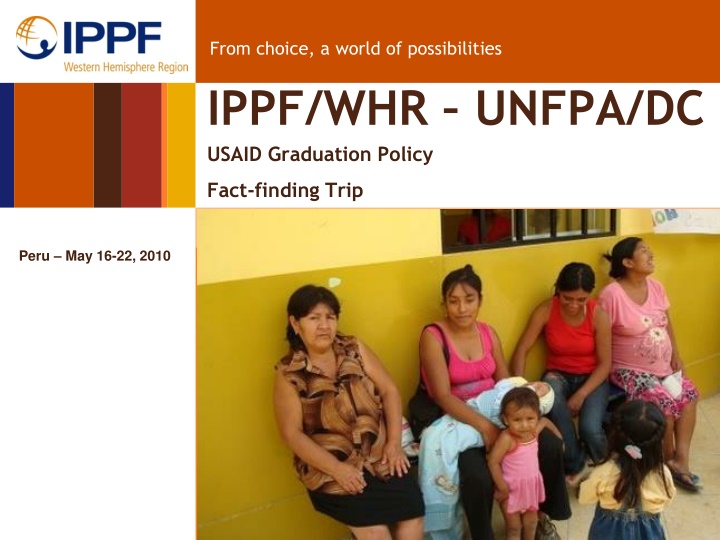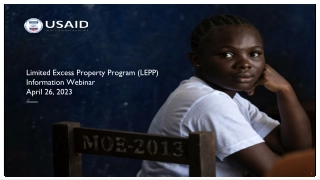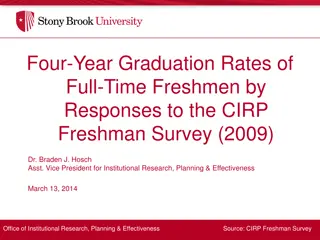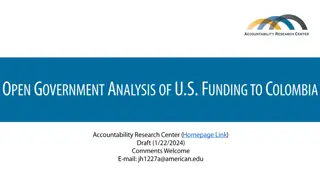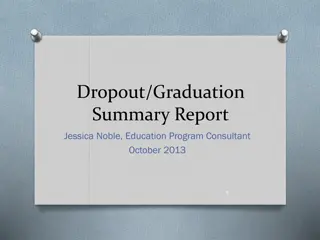Challenges and Criteria for USAID Graduation in Family Planning Programs
Indicators and challenges for graduation from USAID support in family planning programs are discussed, including criteria related to total fertility rate, contraceptive prevalence rate, and access to family planning methods. Challenges such as funding variations, high contraceptive procurement prices, and lack of post-graduation plans are highlighted.
Download Presentation

Please find below an Image/Link to download the presentation.
The content on the website is provided AS IS for your information and personal use only. It may not be sold, licensed, or shared on other websites without obtaining consent from the author.If you encounter any issues during the download, it is possible that the publisher has removed the file from their server.
You are allowed to download the files provided on this website for personal or commercial use, subject to the condition that they are used lawfully. All files are the property of their respective owners.
The content on the website is provided AS IS for your information and personal use only. It may not be sold, licensed, or shared on other websites without obtaining consent from the author.
E N D
Presentation Transcript
From choice, a world of possibilities IPPF/WHR UNFPA/DC USAID Graduation Policy Fact-finding Trip Peru May 16-22, 2010
Government, Service Providers and Communities
USAID Funding for FP/RH Latin America and the Caribbean ($millions) Source: USAID
Working List** for Family Planning Graduation USAID/LAC Region *Does not include condoms for HIV programs **Note that these are planning dates and may be modified
Key USAID Graduation Criteria total fertility rate of 3.0 or less modern contraceptive prevalence rate of a minimum of 50% among married women of reproductive age (15-44) access to at least three different methods of family planning among at least 70% of the population 30% or less of public and private sector FP products, services and programs are funded by USAID Major service providers (public sector, NGOs, commercial sector) generally meet and maintain standards of informed choice and quality of care
Challenges for Graduation I Indicators for graduation from USAID support mask wide variations within countries Funding for FP/SRH depends to a large extent on fiscal conditions, the strength of FP advocacy groups, and shifting policies National governments face higher prices in contraceptive procurement than donors, largely due to smaller scale purchasing Decentralization of health services poses further challenges to contraceptive security
Challenges for Graduation II Most countries not yet graduated and/or slated for upcoming graduation lack a contraceptive security plan post-graduation Decreased donor funding has forced many non- profit providers to move away from serving the poor towards increased user fees Free services, largely provided by Ministries of Health, have tended to be poorly targeted and disproportionately benefited the middle to upper classes rather than the poor
Characteristics of LAC Region SRHR High income inequality High rate of unsafe abortion High rate of teen pregnancy Maternal mortality remains high Contraceptive security challenges
Inequality in Global Comparison Increase budget to support more donor prospecting Developing a strategy for Online Fundraising Completion of the OCR process through our efforts with Euro-American, Bank of America and the Finance department.
Peru at a Glance High income inequality High regional inequality Urban/Rural inequality
Peru SRHR at a Glance 60% of pregnancies unplanned and/or unwanted Contraceptive stock-outs/scarcity Abortion illegal except under therapeutic circumstances Second highest rate of maternal mortality in Latin America
Peru SRHR Political/Policy Context Uneven political support for SRHR over last 20 years Decentralization of Peru s health care system
Figure I. Family Planning Client Profiles in Peru s Ministry of Health, 1996-2004 Source: USAID 2006 (Options for Contraceptive Procurement)
Delegations Findings I Peru -- great progress in addressing its SRH challenges in the last 30 years with USAID as the major donor for SRH/FP But persistent high inequities in access to FP/SRH services among rural, indigenous and poor populations Lack of contraceptive security with frequent stock- outs State governments lack technical capacity, trained staff, or funding necessary to administer health care under health decentralization policies
Delegations Findings II Flawed National insurance plan, in terms of equal access and availability of family planning services Lack of apparent donor coordination, especially with the Global Fund High level of teen pregnancy High level of sexual violence High level of unsafe abortion
Principal Recommendations USAID should temporarily suspend its plan to graduate Peru from USAID FP/SRH funding by 2011 and commit to maintain the level of funding currently provided through FY2015. Conduct anevaluation of the current status of SRH in Peru, which goes well beyond the macro-level indicators currently being used Develop a new SRH graduation plan for Peru which focuses on considering short term funding increases for Peru, before the US reevaluates phasing out support to help ensure that adequate capacity exists for the government to take on responsibility for the SRH needs of the country.
